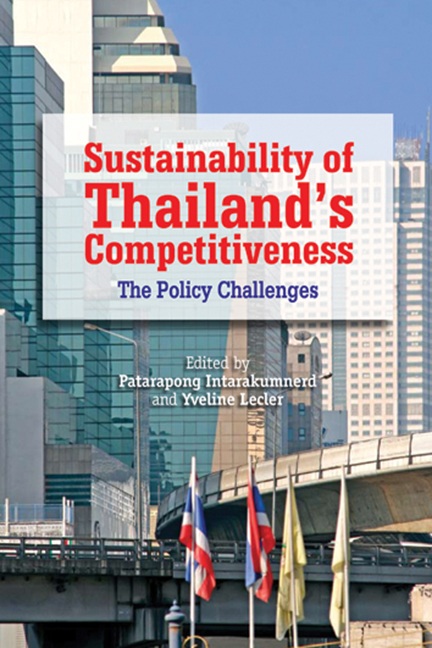Book contents
- Frontmatter
- Contents
- Preface
- Abbreviations
- Contributors
- Introduction
- Part I Thailand's Industrial Development: General Views
- 1 FDI in Thailand: The High Road to Industrial Diversification Revisited
- 2 Catching Up or Falling Behind: Thailand's Industrial Development from the National Innovation System Perspective
- 3 Industrial Upgrading and Educational Upgrading: Two Critical Issues for Thailand
- Part II The Roles of Institutions: Clusters and Industrial Estates
- Part III Firms and Government New Initiatives: The Industry Analysis
- Index
2 - Catching Up or Falling Behind: Thailand's Industrial Development from the National Innovation System Perspective
from Part I - Thailand's Industrial Development: General Views
Published online by Cambridge University Press: 21 October 2015
- Frontmatter
- Contents
- Preface
- Abbreviations
- Contributors
- Introduction
- Part I Thailand's Industrial Development: General Views
- 1 FDI in Thailand: The High Road to Industrial Diversification Revisited
- 2 Catching Up or Falling Behind: Thailand's Industrial Development from the National Innovation System Perspective
- 3 Industrial Upgrading and Educational Upgrading: Two Critical Issues for Thailand
- Part II The Roles of Institutions: Clusters and Industrial Estates
- Part III Firms and Government New Initiatives: The Industry Analysis
- Index
Summary
INTRODUCTION
What were and presently are the kinds of institutional structures and policies that facilitate technological learning and mastery across the broad front needed for industrial development? This is one of the central questions for researchers in several fields of economics, especially, development economics, institutional economics, and economics of technical change and innovation. Understanding differences across countries in their level of development and the reasons for backwardness was, of course, a central concern of the great classical economists, particularly Adam Smith. But these questions gradually moved to the periphery of the field. The question came back into focus after World War II. That the development problem was a catch up problem was put forth explicitly in Alexander Gershenkron's Economic Backwardness in Historical Perspective (1951), which considered the policies and new institutions of the states of continental Europe during the mid and late nineteenth century as they strove to catch up with the United Kingdom, and reflected on the present day relevance of this experience. Moses Abramowitz's propositions (1986) about the institutional and political conditions explaining why countries catch up, forge ahead, and fall behind clearly had this orientation. Nonetheless, we need a “holistic” view to understand a country's industrial development and the underlying reasons behind successful catching up or falling behind. One useful and practical concept is the national innovation system (NIS).
The emergence of the NIS concepts, particularly in the industrialized countries in the northern hemisphere, can be traced back to the work of Lundvall on the national system of innovation or national policies of innovation, and other works (see Freeman 1987, 1988; Nelson 1988) started in the mid-1980s. NIS is the interactive system of existing institutions, private and public firms (either large or small), universities and government agencies, which aim at the production of science and technology (S&T) within national borders.
- Type
- Chapter
- Information
- Sustainability of Thailand's CompetitivenessThe Policy Challenges, pp. 52 - 77Publisher: ISEAS–Yusof Ishak InstitutePrint publication year: 2010

